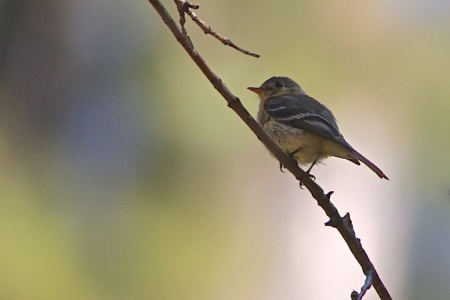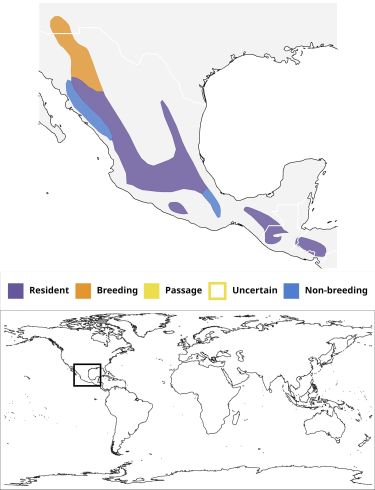
Photo by Stanley Jones
Mt. Lemmon, Santa Catalina Mountains, Coronado National Forest, Pima County, Tucson, Arizona, USA, May 2011
Mt. Lemmon, Santa Catalina Mountains, Coronado National Forest, Pima County, Tucson, Arizona, USA, May 2011
- Empidonax fulvifrons
Identification
11.5-13cm The smallest Empidonax flycatcher
- Olive grey above
- Darker wings and tail
- White eye ring
- Strong white double wing bars
- Rich buff colored breast (most vivid July-February)
- Short flat bill
Distribution
North and Central America: found from Honduras to Western Mexico, extending northward in a band to barely enter extreme south-eastern Arizona.
Taxonomy
Subspecies
There are 6 subspecies1:
- E. f. pygmaeus - south-western US and north-western Mexico (Sonora to Coahuila)
- E. f. fulvifrons - mountains of northeast Mexico (Tamaulipas and San Luis Potosí)
- E. f. rubicundus - Mexico (Chihuahua and Durango to Guerrero and Veracruz)
- E. f. brodkorbi - southern Mexico (Río Molino area of southern Oaxaca)
- E. f. fusciceps - south-eastern Mexico (Chiapas) south to Guatemala and El Salvador
- E. f. inexpectatus - central and southern Honduras
Habitat
Scrub and open woodlands, wooded canyons.
Behaviour
Diet
The diet includes insects.
Breeding
A cup nest is placed on a fork in a tree. The clutch consists of 2 eggs.
References
- Clements, J. F., T. S. Schulenberg, M. J. Iliff, B.L. Sullivan, C. L. Wood, and D. Roberson. 2012. The eBird/Clements Checklist of Birds of the World. 6th ed., with updates to October 2012. Ithaca: Cornell Univ. Press. ISBN 978-0801445019. Spreadsheet available at http://www.birds.cornell.edu/clementschecklist/downloadable-clements-checklist
- Wikipedia
Recommended Citation
- BirdForum Opus contributors. (2024) Buff-breasted Flycatcher. In: BirdForum, the forum for wild birds and birding. Retrieved 1 November 2024 from https://www.birdforum.net/opus/Buff-breasted_Flycatcher




